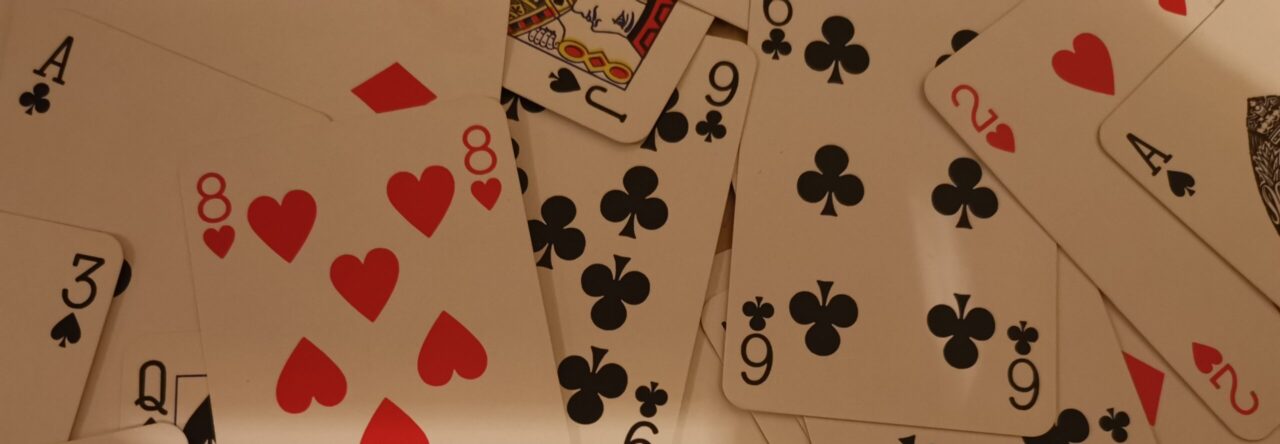I like to call it the frivolous 3NT – but many people will call this convention non-serious 3NT. If we start with an auction with no intervening bidding such as:-
- 1♠ – 2♣
- 2♠ – 3♠
- ?
If we have agreed an 8 card fit in the majors then most of the time it’s going to play better in 4♠, therefore if we give up the 3NT bid as a natural bid, we can use it for something more constructive….The Frivolous 3NT.
Based on the principal of fast arrival 3♠ here can show a better hand. We can now use 3NT as the more useful Frivolous 3NT conventional bid.
So what are the kinds of hand that would bid 3NT, cue bid, or just bid 4♠?
Hands that would bid the Frivolous 3NT
| a) | b) | c) | d) We open 1♣ |
| ♠ AQ10863 ♥ A62 ♦ K84 ♣ 7 | ♠ KQ10754 ♥ KQ8 ♦ 3 ♣ K65 | ♠ AKJ1072 ♥ 108 ♦ K2 ♣ QJ10 | ♠ KJ876 ♥ K2 ♦ K106 ♣ KJ7 |
Hands that would Cue Bid
| a) | b) | c) | d) We open 1♣ |
| ♠ AQ10863 ♥ AKQ ♦ Q72 ♣ 7 | ♠ KQ10754 ♥ Q8 ♦ A72 ♣ A5 | ♠ QJ10972 ♥ AK ♦ AQ ♣ Q72 | ♠ KQJ86 ♥ AJ2 ♦ K106 ♣ A7 |
Hands that would bid straight to game
| a) | b)We open 1♣ | c)We open 1♣ | d) |
| ♠ KJ10863 ♥ KJ ♦ KJ ♣ 732 | ♠ KQ754 ♥ KQ8 ♦ Q2 ♣ J72 | ♠ K10972 ♥ AK7 ♦ Q7 ♣ 972 | ♠ K987432 ♥ KQ ♦ QJ ♣ 94 |
Which auctions are Frivolous 3NT?
So in all the following Frivolous 3NT applies….
Auction 1
- 1♠ – 2♣
- 2♠ – 3♠
- 3NT
Okay if you cannot spot this as frivolous 3NT you’re in trouble!
Auction 2
- 1♠ – 2♥
- 3♥ – 3NT
The Frivolous 3NT convention may be used by either partner as this is a 2/1 game forcing auction.
Auction 3
- 1♠ – 2♥
- 3♥ – 3♠
- 3NT
Frivolous 3NT may be used after an intervening cue bid.
Auction 4
- 1♠ – 2♣
- 3♣ – 3♠
- 3NT
Frivolous 3NT may be used after an intervening raise of responder.
Auction 5
- 1♠ – 2♦
- 2NT – 3♠
- 3NT
Frivolous 3NT applies even if opener rebid a natural 2NT as long as the major is raised.
Auction 6
- 1♠ – 2NT
- 3♣ – 3♦
- 3♠ – 3NT
Frivolous 3NT applies after any game forcing raise of a major, even without a 2/1. Here the responses are to Swedish Jacoby.
What Auctions aren’t frivolous 3NT?
Auction 1
- 1♠ – 2♣
- 2♠ – 2NT
- 3♣ – 3♠
- 3NT?
Here the 3♠ bid only shows 2 card support so the 3NT can be natural.
Auction 2
- 1♠ – 2♣
- 2♥ – 2♠
- 3NT?
Jumps to 3NT aren’t frivolous…you can simply cue-bid over 2♠ or bid 3♠
Auction 3
- 1♠ – 2♣
- 2♥ – 3♠
- 3NT?
3♠ is a strong picture jump raise therefore the Frivolous 3NT is not needed when the partnership is already known to be in the slam zone. This could be a case of wanting partner to cue bid 4♣ before you bid 4♦
Auction 4
- 1♠ – 2♦
- 3♠ – 3NT
The 3♠ bid is similar to the last auction is a strong picture jump suit rebid setting the suit.
Frivolous 3NT is not needed since the partnership is already known to be in the slam zone.
Auction 5
- 1♠ – 1NT
- 2♣ – 3♠
- 3NT
Since the 3♠ is a 3-card limit raise. Here the Frivolous 3NT is off since responder’s 3♠ raise did not create a game force.
Well I hope that wets your appetite!
